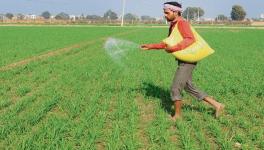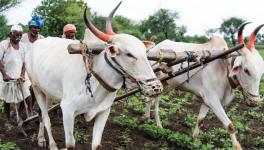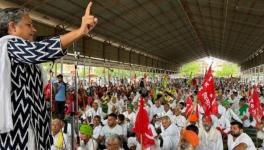Farmers are Spot On: Guaranteed MSP will Make India Stronger
Farmer unions have said that repealing the three new farm laws and giving a legal guarantee for Minimum Support Prices will enable India to give 15 instead of five kilos of food to households through the Public Distribution System under the National Food Security Act, 2013. The government has said that it will not repeal the three laws, nor would it be possible to provide a legal guarantee for minimum prices for all 23 crops because it will cost Rs.17 lakh crore.
The unions have correctly linked the issue of food security to agricultural production through an incentivised MSP, because that is exactly what led India to move towards self-sufficiency in food staples from the seventies on. And yet, only half the battle has been won. Grains still stockpile while hunger stalks the poor. Its integration with a universalised PDS is what can become the real face of an inclusive Indian nationalism.
The Green Revolution was launched to reach self-sufficiency in food and to get rid of our reliance on American food aid on humiliating terms. It was the farming fields of Punjab, Haryana and western Uttar Pradesh, the very epicenter of the current protests, that helped India move from a country with a begging bowl to an emerging important country.
The procurement, storage and public distribution systems from the Green Revolution period provided assured price incentives in the shape of MSP for rice, wheat and sugar and more importantly an expanding domestic market for food crops. Of the diverse array of food grains available across the country, only rice, wheat and sugar were provided from the ration shops in most states. The government procured grains to keep as buffer to ensure food security for Below Poverty Line households (i.e., the Targeted-Public Distribution System), which earlier covered the entire population as the more ambitious Universal Public Distribution System.
Since price setting and procuring of this volume of food grains had several components including MSP, the total economic costs which set the price for distributing food grains from fair price shops (i.e., Central Issue Price) lower than market price was the difference between the economic costs borne by the government and the recovery through the central issue price channel; which becomes the subsidy for ensuring food security.
Price setting and procuring of this volume of food grains would consist of quite a few economic costs including MSP. There is a lower than market price for distributing food grains from fair price shops, that is the Central Issue Price. The difference between the economic costs borne by the government and the recovery through the central issue price channel is the subsidy for food security.
HOW MUCH DOES FOOD SECURITY COST?
Let us take the MSP issue first, which is in the eye of the storm. MSP remains notional until the crop is actually procured, so calculating declared MSP prices for all crops at Rs.17 lakh crore is misleading. This is because mostly rice and wheat are procured through it, and that too just a percentage [between 40-50%] of the total production of these two crops. MSP sometimes also acts as a price stabiliser in the market. Thus, the government procuring a small percentage of the crop [e.g., 25% of pulses production] can lead to stabilisation of the larger market price.
India has been producing way over the buffer stock norms for the past few years, and hence at best only 30-40% of this cost will actually be borne by the government. This would range between Rs.5-7 lakh crore. Providing 5 kilos per household to two-thirds of the population under the NFSA should cost between Rs.1.8 lakh crore and Rs.2 lakh crore.
Of course, some of this cost will be recovered through selling at PDS shops at the Central Issue Price. So, accepting the farmers’ demands at the current level of implementation of the NFSA would not cost more than Rs.7-8 lakh crore. In fact, the government can universalise PDS or increase the provision of every household from five to 15 kilos at an additional cost of not more than Rs.2-3 lakh crore. In other words, an annual expenditure of Rs. 7-8 lakh crore would meet the farmers’ demand and ensure agricultural production and food security for the poor.
Additionally, if the government cuts down on its import bill of certain items, such as pulses, surely, we can be atmanirbhar in terms of daily consumption items which the farmers could grow in plenty under assured prices.
WHERE WOULD THE MONEY COME FROM?
The oft-repeated clamour in the corridors of power is that this will enlarge the fiscal deficit. This argument is regularly brandished whenever it comes to subsidies in terms of food, basic education, health, housing or employment, i.e., anything which strengthens the safety net for the poor.
However, alternatives exist, and to be able to imagine these alternatives is the beginning of atmanirbharta. Indeed, a road map for this has become distinctly more visible during the last year of a near-complete lockdown and comatose economy. It is no secret that even in a recession, where global and local GDP contracted at an unprecedented rate, the stock markets grew by 12-13%.
The wealth of the top few has increased even in a year of a pandemic and lockdown, and the turnover of the stock market for a single day in November 2020 was to the tune of Rs.1.47 lakh crore—the amount required annually for the NFSA.
As on 11 January, the investor wealth (market capitalisation) measured by the Bombay Stock Exchange stood at Rs.196 lakh crore. Surely a less than 1% atmanirbharta tax would be a drop in this ocean?
Could not the government levy a mere 0.5% turnover tax on transactions in the stock market and fetch Rs.4-5 lakh crore annually, while an atmanirbharta tax at 1% would cover more than all the costs that the farmers’ demands entail, plus enormous food security to poor India? There are also other sources to tap, such as the liquidation of non-performing assets of nationalised banks through properly formulated bankruptcy laws, higher taxes on wealth of the multibillionaires, and so on.
Real national economic sovereignty should begin with such steps. The farmers’ movement has opened up the possibility of such a solution, while the government remains the problem. The Central Vista of a larger expensive Parliament building or even the tallest Rama temple is no substitute for this solution, even with the support of media or paid economic pundits. Because you can fool some people for some time but not all people for all times. This indeed is the unmistakable message resonating far and wide with the growing farmers’ movement.
The author is associate professor of Global Studies, Ambedkar University Delhi. The views are personal.
Get the latest reports & analysis with people's perspective on Protests, movements & deep analytical videos, discussions of the current affairs in your Telegram app. Subscribe to NewsClick's Telegram channel & get Real-Time updates on stories, as they get published on our website.
























